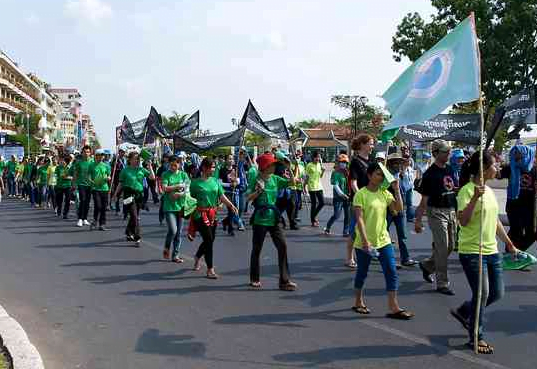It’s becoming increasingly dangerous to be a peaceful protester in many parts of the world, and impoverished, corrupt Cambodia is no exception.
Since November 2011, gun violence against peaceful protesters has been on the rise in this troubled Southeast Asian nation. Local NGO Licadho has found that five land-dispute protests turned violent between November and January of 2012, while a city governor has been personally involved in a February garment factory dispute. Almost no arrests have been made in these incidents, and the police seem markedly disinterested in pursuing prosecution.
In what has become perhaps the most widely publicized case, a city governor personally fired into a crowd of 1000 garment factory protesters in Bavet, seriously injuring a 21-year-old woman and wounding two others. Bavet city governor Chhouk Bandith promptly disappeared after the shooting, although he allegedly showed up at the woman’s hospital to ask her not to press charges in exchange for money.
Even Cambodia’s deputy prime minister has jumped into the fray, after local police, at his request, offered the 21-year-old victim $500 if she did not press charges. The young woman, who is nursing a serious chest injury, refused the money, committing a noble act that may come to haunt her later under Cambodia’s current leadership. As for the governor, he has lost his job – although he will still retain a provincial government post of some kind.
Why did the garment factory workers take to the streets? Compared to the rest of the region, they are poorly paid, with a minimum wage that is the lowest in the region according to Licadho, despite the considerable profits Cambodia is drawing from their efforts. Western consumer tastes are also at least indirectly implicated in these Cambodian workers plights: the Kaoway Sports company targeted by the protesters sources to a number of popular shoe brands, including Puma, Clarks, New Balance, and Ecko.
Protesters have also been shot attempting to protect their villages and ancestral forests from rampant development and logging. On March 8, the deputy governor of Kampong Thom told members of the activist Prey Long Forest Network that he won’t take responsibility if they are shot while attempting to prevent logging.
His threats probably aren’t idle: on January 18th, the general manager of a development company allegedly ordered security guards to fire into a crowd of 400 villagers protesting the demolition of their cassava crops in Kratie province, seriously injuring one man and wounding 3 others. The general manager was finally arrested on March 5th, and judging from recent history, it seems unlikely he will receive more than a slap on the wrist.
The recent outbursts of violence seem to overwhelmingly feature a powerful Cambodian with a vested business interest—in the private or public realm—ordering the shooting of peaceful protesters because they can, and because they know that it is unlikely they will be punished harshly for their actions.
Cambodia receives a large amount of international aid and NGO assistance, and these violent incidents against protesters asking only for the basic necessities of life may make international observers wonder if all the money that’s been invested in Cambodia’s democratic process is really doing much good. It may fall to international policy-makers and businesspeople to push the Cambodian government to treat its own citizens with the basic respect they deserve.
